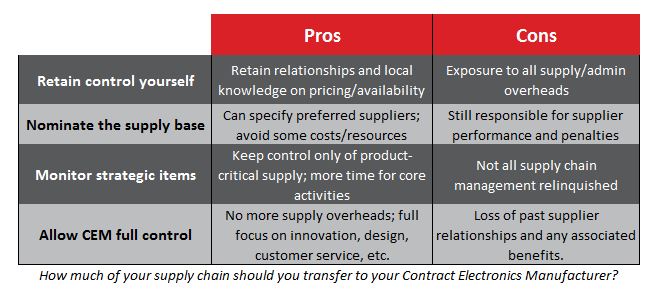You've decided to take your first steps into outsourcing and have drawn up a shortlist of potential partners. But before any more progress can be made, you've got some important decisions to make.
For instance, how much of your existing supply chain should you transfer to your contract electronics manufacturer (CEM) - if any at all?
There are a few options to consider before you can make that decision. Here are the different scenarios and the pros and cons of each:
1. Retain control over everything
Retaining full control over your supply chain means you will continue to buy your materials through your own supply chain before 'free issuing' them to your assembly partner for manufacturing. In this scenario, you will have complete control over the pricing, contracts and the terms of agreement that you already have in place.
The upside of this arrangement is that you'll still be able to utilise your own knowledge that you may have spent years building up. This means that you'll have your own market intelligence on the pricing and availability of the materials you use, which could provide peace of mind. However, this will only be beneficial if you are sure your CEM's broader, and perhaps more established, supply base couldn't offer you a more cost-effective, quality driven option.
The drawback of retaining complete control is that you will also retain the overheads and administration associated with maintaining a purchasing and supply chain management capability. It could also mean that you are penalised by your assembly partner for late shipments, damaged items or inferior materials if these hold up the process.
2. Nominate the supply base
If you are keen to retain control, but would like to avoid all of the costs, storage and management time associated with free-issuing materials to your supplier, there is a balance to be had. It is possible to nominate your preferred suppliers to your CEM, who will then continue to work directly with them. Whilst it does mean you are able to delegate some of the functions associated with procurement, you could still find yourself responsible for top-level supplier management and their performance and could therefore still be penalised for any shortfalls in delivery, quality, etc.
3. Keep an eye on your strategic items
The next scenario allows you to keep control of the source, pricing and quality on those items that are critical to your design, while passing over the operational activities for the rest of the materials to your contract manufacturing partner.
This partial transition significantly reduces the management time spent on supply chain issues. You will, for instance, only be expected to input on a small number of parts and can focus your efforts on maintaining or increasing the quality of your suppliers for these parts. It'll also mean you'll have more time to spend on the core activities of your operation, for instance, innovation, design, marketing or improving customer service.
4. Allow your CEM full control
Passing the control of the entire supply chain to your assembly partner could mean stepping back from some key supplier relationships you've had and the benefits that these can bring. This can be a big move. But there are significant gains to be had with this arrangement, given the focus that a good contract manufacturing partner will have on supply chain excellence.
Firstly, you'll free up more time and administration by taking away all of the overheads associated with procurement and materials handling. When you consider 80% of the value and lead-time of an electronic assembly is typically tied up in the materials, this could have a significant operational effect.
Secondly, you stand to gain from your CEM's wider supplier base with the possibility of capitalising from better pricing, higher quality and improved delivery performance as a result.
Thirdly - and arguably one of the most prominent benefits of passing over all control to your CEM - is that you will be in a position to focus completely on the other areas of your business - for instance, design, marketing and customer service - that are likely to bring you better returns.
Tough choices
When it comes to deciding on the particular outsourcing arrangement that would best suit your firm's needs, there is a lot to consider. But it's important to remember that the agreement you have with your CEM could evolve and change over time.

If you feel initially that you need to keep a level of control, nominating the suppliers for your strategic items at the start of your agreement could makes sense. Then, once you have built up a level of trust and your outsource partner is consistently delivering product to you, on time and in full, you may feel confident enough for them to take over the supply chain fully, allowing you to benefit from their broader supplier base and specific expertise.

